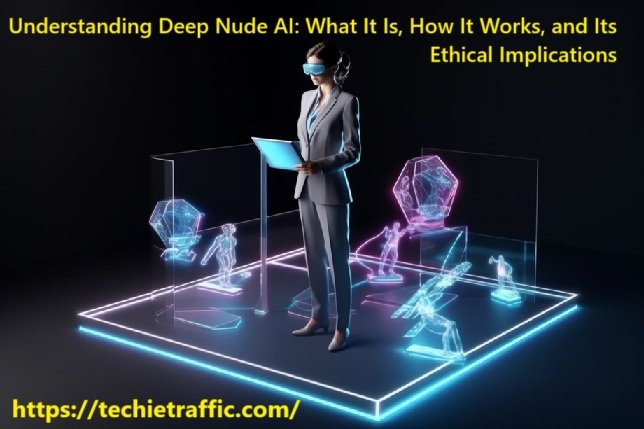Introduction: Deep Nude AI
In the ever-evolving landscape of artificial intelligence (AI) and machine learning (ML), new technologies emerge that both excite and concern the public. One such technology that has stirred debate and raised serious ethical questions is Deep Nude AI. This technology, which uses AI to generate realistic nude images by altering or “deepfaking” photos of individuals, has sparked a variety of discussions on privacy, consent, and the potential for misuse.
In this article, we will take a deep dive into what Deep Nude AI is, how it works, the potential risks it poses, and the ethical issues surrounding its use. We’ll also examine the laws and regulations surrounding AI-generated content, and provide actionable tips on how to protect yourself from potential misuse of such technologies.
1. What Is Deep Nude AI?
Deep Nude AI refers to a type of artificial intelligence that uses deep learning techniques to alter images or videos, often creating realistic depictions of people that do not correspond to reality. Originally, the term “Deep Nude” was associated with a controversial application designed to “strip” clothing from images of people. This application gained notoriety for its unethical use, especially as it was primarily used to create explicit images without consent.
However, the technology behind Deep Nude has since been repurposed in various ways, including for artistic, educational, and legitimate purposes. While some of these uses are harmless, the core technology remains controversial due to the risks it presents in terms of privacy violations, harassment, and the broader implications of AI-generated content.
2. How Does Deep Nude Work?
Deep Nude AI is based on a subset of machine learning called Generative Adversarial Networks (GANs). These are composed of two neural networks: the generator and the discriminator. Here’s how the process generally works:
-
The Generator: This AI creates images based on the data it has learned from a large set of images (e.g., photos of clothed individuals). It learns the details of human anatomy and body features to make modifications to existing images.
-
The Discriminator: This AI evaluates the images created by the generator, determining whether they look like real images. The generator then adjusts based on feedback to improve the realism of the output.
Through repeated iterations, the AI becomes more adept at generating increasingly convincing and realistic images, which is why the results can appear so lifelike.
3. Technologies Behind Deep Nude
Deep Nude AI relies on several advanced AI and machine learning techniques. Below is a breakdown of the primary technologies used:
| Technology | Description |
|---|---|
| Generative Adversarial Networks (GANs) | GANs are used to generate realistic images by competing against a discriminator model, refining the quality of the output. |
| Convolutional Neural Networks (CNNs) | CNNs are used in image processing and recognition. They help the AI understand and manipulate features in images. |
| Autoencoders | Autoencoders are used to compress data and recreate images, often aiding in the transformation process. |
| Transfer Learning | This technique uses pre-trained models to apply knowledge learned from one task to another, speeding up the learning process. |
These technologies allow Deep Nude AI to generate highly detailed and convincing images, but they also make it difficult to discern between real and artificial content.
4. The Ethics of Deep Nude
The ethical issues surrounding Deep Nude AI are manifold and complex. Here are some of the key concerns:
A. Consent Issues
The most significant ethical issue with Deep Nude AI is that it often generates explicit images of people without their consent. This violates individual rights to privacy and can cause significant emotional harm to those affected.
B. Harmful Impact on Women
Deep Nude AI has been disproportionately used to create explicit content featuring women. This has raised concerns about how AI technology is being exploited to perpetuate sexism, harassment, and violence against women.
C. Anonymity and Accountability
One of the challenges with AI-generated content is that the creators and users can often remain anonymous. This can make it difficult to hold anyone accountable for the creation and distribution of harmful content.
D. Deepfakes and Misinformation
Deep Nude AI is a type of deepfake technology, which has broader implications for misinformation. Deepfakes can be used to create fake news, manipulate political discourse, and undermine trust in media.
5. Legal Implications of Deep Nude
As AI technology progresses, legal systems around the world are struggling to keep up with the complexities of issues like Deep Nude AI. Here are some key areas where the law is beginning to intervene:
A. Privacy Laws
In many countries, individuals have a legal right to control how their likeness is used. The creation of AI-generated explicit content without consent may violate privacy laws and intellectual property rights.
B. Harassment and Defamation
Deep Nude AI has been used to create explicit content aimed at harassing or defaming individuals. In many cases, this could lead to legal action for harassment, emotional distress, or defamation.
C. Copyright and Intellectual Property
Creators of original images and videos may have legal claims against the use of their likenesses in AI-generated content. This raises important questions about ownership and rights over digital content.
6. Risks and Dangers of Deep Nude
While Deep Nude AI can be used for seemingly harmless purposes, it carries significant risks:
-
Privacy Violations: Without consent, the creation of AI-generated explicit content can be a direct violation of an individual’s privacy.
-
Reputational Damage: People targeted by such content may suffer severe reputational damage, both personally and professionally.
-
Psychological Impact: Victims of AI-generated explicit content may experience emotional distress, anxiety, and other mental health issues.
-
Cyberbullying and Harassment: Deep Nude AI could be weaponized for online harassment or cyberbullying, particularly against vulnerable groups.
7. Protecting Yourself from Deep Nude
Here are several ways you can protect yourself from becoming a victim of Deep Nude AI:
A. Digital Privacy and Security Measures
- Use privacy tools and services to protect your personal information online.
- Enable two-factor authentication on your accounts to make it harder for malicious actors to steal your data.
B. Legal Protections
- Familiarize yourself with your rights under privacy laws and intellectual property protection laws.
- Contact a lawyer if you become a victim of AI-generated content to discuss legal remedies.
C. Advocacy and Support
- Get involved in advocacy groups that work to protect privacy and fight against online harassment.
- Seek support from mental health professionals if you’re experiencing distress related to AI-generated content.
8. The Future of AI-Generated Content
The rise of AI technologies, including Deep Nude, presents both opportunities and challenges. The future of AI-generated content will likely involve more sophisticated tools for content creation, as well as greater regulation to prevent abuse.
A. Regulation and Ethics
Governments and organizations will need to put in place stronger laws and guidelines to protect individuals from harmful AI-generated content. Ethical guidelines will also play a key role in determining what is acceptable and what is not in AI development.
B. AI in Creative Industries
On the positive side, AI can be used for creative purposes, such as generating art, music, or digital fashion. As AI tools continue to evolve, they may bring about new opportunities in these fields while minimizing risks to individuals.
9. Conclusion
Deep Nude AI is a powerful and controversial technology that highlights the complex intersection of artificial intelligence, privacy, and ethics. While it has legitimate applications in creative industries, it also poses significant risks, particularly regarding consent, privacy, and harm to individuals.
As AI technology continues to evolve, it is crucial for society to address the ethical and legal implications of such technologies and ensure that appropriate safeguards are in place to protect people from misuse.
For individuals concerned about their own privacy and digital safety, it is essential to stay informed and proactive in protecting personal information online.
Final Thoughts
By understanding the technology behind Deep Nude AI, its potential for harm, and the ethical and legal questions it raises, we can navigate the complexities of the digital age with greater awareness and responsibility.
Read More Blogs: How to Redeem AI Services: A Complete Guide to Redeem AI. Site


